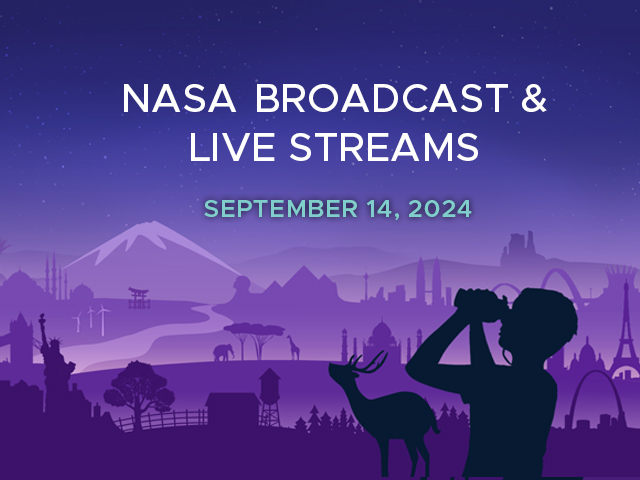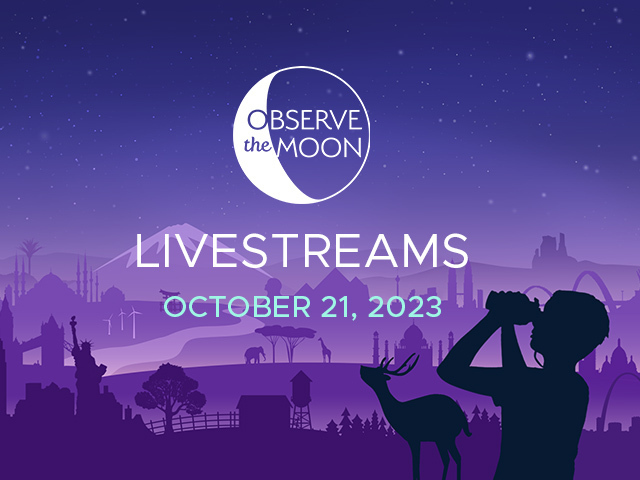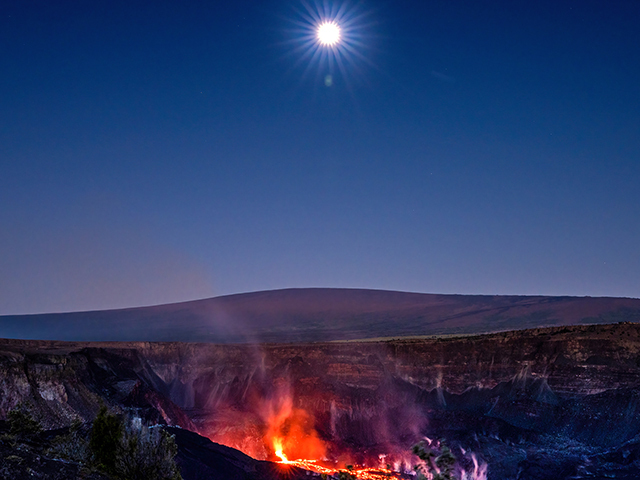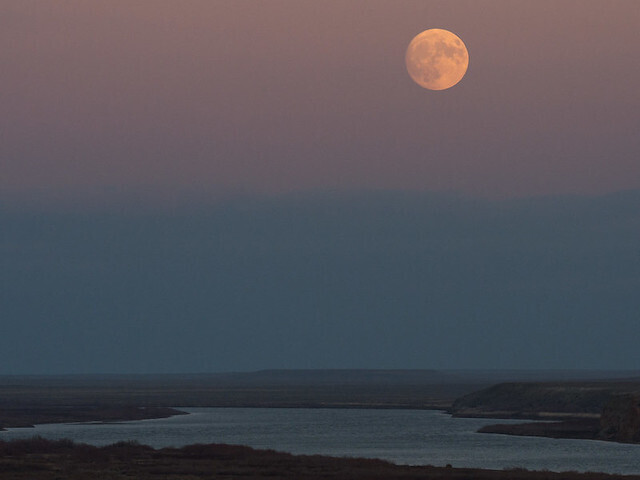News | September 21, 2018
Full Moon Blog: The Next Full Moon is the Harvest Moon
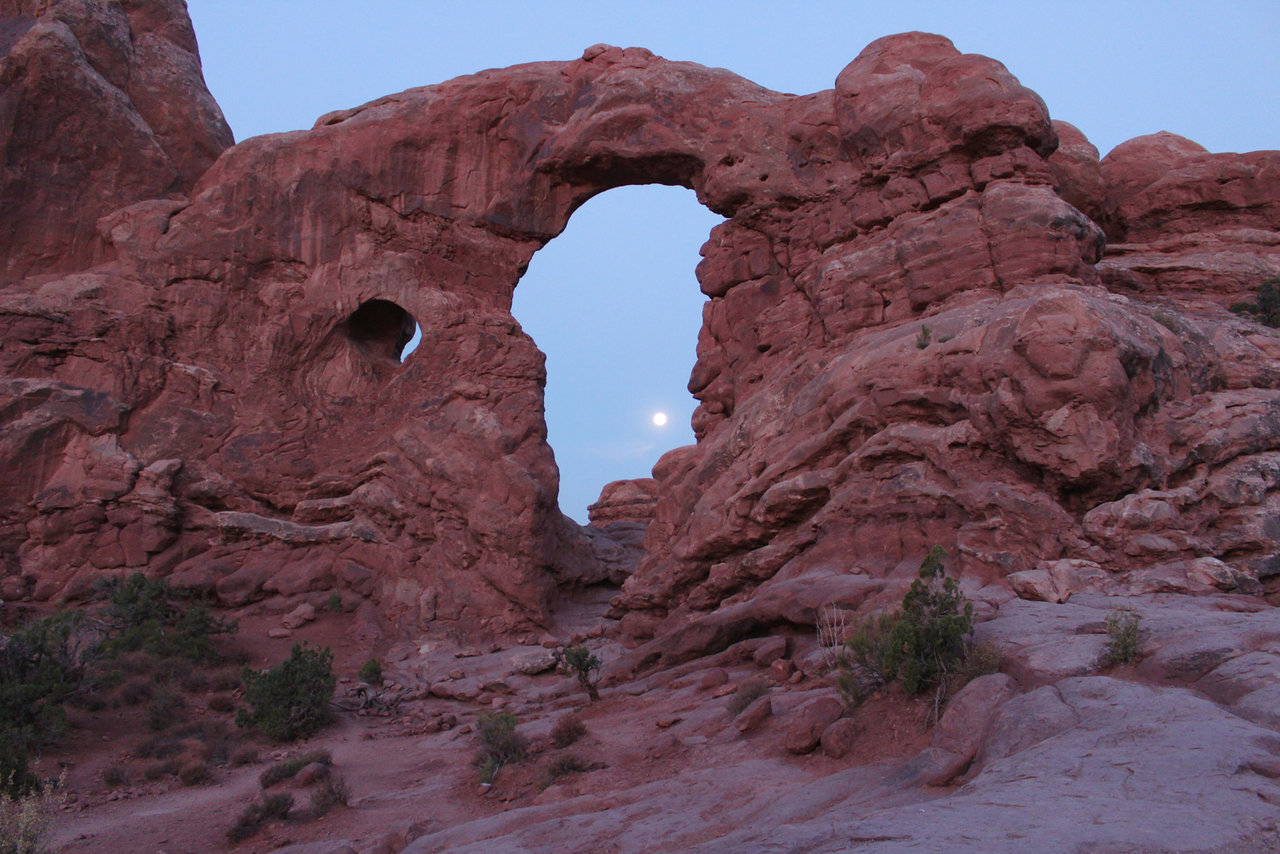
The early morning Moon sets behind Turret Arch in Arches National Park, Utah on July 28, 2018. Credit: NASA/Bill Dunford
The next full Moon will be on Monday night, September 24, 2018, appearing "opposite" the Sun (in Earth-based longitude) at 10:52 PM EDT. Since 10:52 EDT is after midnight in Universal Time, many almanacs and mass-produced calendars will show this full Moon as being on Tuesday, September 25, 2018. The Moon will appear full for about three days centered around this time, from Sunday evening through Wednesday morning.
The Harvest Moon
As the full Moon closest to the Autumnal Equinox, this is the Harvest Moon. Farmers can work late into the night by the light of this Moon. Usually the full Moon rises an average of 50 minutes later each night, but for the few nights around the Harvest Moon, the Moon seems to rise at nearly the same time each night: just 25 to 30 minutes later across the northern U.S., and only 10 to 20 minutes later for much of Canada and Europe. The Harvest Moon is an old European name for this full Moon; the Oxford English Dictionary cites the year 1706 for the first published use of the name "Harvest Moon."
Fall Feasts and Festivals
In China, Vietnam, and some other Asian countries, this full Moon corresponds with the Mid-Autumn Festival, a traditional harvest festival. In China, other names for this festival include the Moon Festival, the Mooncake Festival, and the Reunion Festival (traditionally women in China would visit their parents, then return to celebrate with their husbands and his parents). Part of the festival includes offerings to the Moon Goddess Chang'e (the name the China National Space Agency gives their lunar missions). In Korea, this full Moon corresponds with the harvest festival Chuseok, during which Koreans leave the cities to return to their traditional hometowns and pay respects to the spirits of their ancestors.
For some Buddhists in Bangladesh and Thailand, this full Moon is Modhu Purnima, the Honey Full Moon Festival, or the Honey-offering Festival, tied to a legend that and elephant and a monkey fed the Buddha when he was in the forest to bring peace between two factions, with the elephant offering fruit and the monkey offering a honeycomb. In Sri Lanka, this full Moon is the Binara Full Moon Poya Day, commemorating the establishment of the Buddhist Bikkhuni Order.
In the Hebrew calendar, this full Moon falls near the start of the Sukkoth holiday, a 7-day holiday tied to the 15th day of the lunar month of Tishrei (the 15th day of a lunar month is always close to if not the same as the day of the full Moon). Sukkoth is also known as the Feast of Tabernacles or the Feast of the Ingathering. Sukkoth ties back to both the sheltering of the People of Israel during the 40 years in the wilderness in the Book of Leviticus and a harvest festival in the Book of Exodus. Often for this holiday a temporary hut symbolic of a wilderness shelter is built, and the family eats, sleeps, and spends time in this shelter. This year, the 7-day holiday of Sukkoth starts a sunset on September 23, 2018.
Moon Lore
The Maine Farmer's Almanac first published Indian names for the full Moons in the 1930's. According to this almanac, the Algonquin tribes of what is now the northern and eastern United States named the first full Moon of fall the Travel Moon, the Dying Grass Moon, or the Sanguine or Blood Moon. Some sources indicate that the Dying Grass, Sanguine, and Blood Moon are thought to be related to the turning of the leaves and dying back of plants with the start of fall. Others indicate that that the names Sanguine or Blood Moon are associated with hunting and correspond with the full Moon after this,the Hunter's Moon. I have read that the name "Travel Moon" comes from observing the migration of birds and other animals preparing for the winter. I don't know, but my guess is this name may also refer to the season when the more northern tribes would move down from the mountains for the winter. For example, both the Iroquois and Algonquin would hunt in the Adirondacks in the summertime but would leave for winter.
Many writers tie these Native American names to the European months, so that the full Moon in September is the Full Corn Moon, regardless of whether it is the last full Moon of Summer or the first full Moon of Fall. To me, it makes more sense that the Native American tribes tied their Moon names to the seasons, with the the last full Moon of Summer the Corn Moon (in August this year) and the first full Moon of Fall the Travel Moon or Dying Grass Moon. For the next few seasons the Moon names by European months are out of sync with the Moon names by season. In the Spring of 2019 we will have a season with four full Moons and this will get the names back in sync again. In any case, I expect that the Native American Moon names varied by tribe and region, as (for example) when the grass starts to die in the tribe's local area, and like lots of folk traditions, there is no single "right" answer.
Moon Missions
Newer names for this full Moon are the GRAIL Moon and the LADEE Moon. On September 10, 2011, the twin Gravity Recovery and Interior Laboratory (GRAIL) spacecraft started their voyage towards the Moon on a Delta II launch vehicle. On September 6, 2013, the Lunar Atmosphere and Dust Environment Explorer (LADEE) spacecraft started its journey to the Moon on a Minotaur V launch vehicle.
In recent years, another tribe has arisen that has given a special name for this full Moon. This tribe is geographically distributed but united in a common cause. Their language is a blend of scientist- and engineer-speak, but they agree on naming this the OSIRIS-REx Moon, in honor of the spacecraft they launched two years ago, on Thursday, September 8, 2016, on its way to Bennu to bring back pieces of this asteroid for study on Earth, not just to answer questions we have today, but to answer the questions of future researchers, questions we have not thought of yet, using laboratory instruments we have not invented yet. The OSIRIS-REx spacecraft is approaching Bennu now and will arrive on December 3, 2018. OSIRIS-REx will deliver samples of Bennu back to Earth in September 2023.
Mark Your Calendars
In lunisolar calendars the months change with the new Moon and full Moons fall in the middle of the lunar month. This full Moon falls near the middle of the eighth month in the Chinese calendar and Tishrei in the Hebrew calendar. In the Islamic calendar the months start with the first sighting of the waxing crescent Moon a few days after the New Moon. This full Moon is near the middle of Muharram, the first month of the Islamic year.
As usual, the wearing of suitably celebratory celestial attire is encouraged in honor of the full Moon. And you might want to consider celebrating the harvest, enjoying a mooncake; visiting your hometown, parents, and in-laws; enjoying some honey, and camping out.
As for other celestial events between now and the full Moon after next:
As Fall begins (for the Northern Hemisphere), the daily periods of sunlight continue to shorten. For the Washington, DC area, on the day of the full Moon on September 24, morning twilight will begin at 6:00 AM, sunrise will be at 6:58 AM, the Sun will reach a maximum altitude of 50.5 degrees at 1:00 PM, sunset will be at 7:02 PM, and evening twilight will end at 7:59 PM EDT.
By the day of the full Moon on October 24, morning twilight will begin at 6:28 AM, sunrise will be at 7:27 AM, the Sun will reach a maximum altitude of 39.2 degrees at 12:52 PM, sunset will be at 6:17 PM, and evening twilight will end at 7:16 PM EDT.
On the evening of the September full Moon, for the Washington, DC area (and similar latitudes), the brightest of the planets, Venus, will appear at nearly its brightest for this apparition, but also very low near the horizon in the west-southwest, setting right around the time evening twilight ends. To see Venus you will need a clear view of the horizon. Venus will be bright enough to see shortly after sunset while it is still higher in the sky. When Venus is visible in the evening, it is known as Hesperus, Vesper, or the Evening Star. As evening twilight ends, Jupiter, appearing as second brightest planet in the sky, will be about 25 degrees above the horizon in the southwest, to the upper left of Venus. The third brightest planet in the sky, Mars, will appear about 25 degrees above the horizon in the south-southeast. The planet Saturn will appear a little west of south at about 27 degrees above the horizon. Jupiter was at its closest and brightest for the year in May, and remains bright even as it shifts closer to passing around the far side of the Sun as seen from Earth. The planet Saturn was at its closest and brightest for the year in late June. The bright star nearly directly overhead will be Vega, one of the three stars in the "Summer Triangle" made up of Vega, the brightest star in the constellation Lyra the Harp; Deneb, the brightest star in the constellation Cygnus the Swan; and Altair, the brightest star in the constellation Aquila the Eagle.
As the month progresses the stars, along with Jupiter, Saturn, and Mars, will appear to shift more towards the west, while Venus will quickly appear to shift towards the Sun passing between the Earth and the Sun on October 26, 2018. Even though Venus is becoming more and more of a crescent (when viewed with a telescope or binoculars) and shifting closer to the horizon, it is also shifting closer to the Earth, so it will reach its greatest brilliancy on September 25, 2018 ("greatest brilliancy" is an approximation for greatest brightness), before quickly dimming and disappearing in the glow of dusk. By the evening of the October full Moon, as evening twilight ends, the planet Venus will no longer be visible, Jupiter will be close to setting, appearing just 2 degrees above the horizon in the west-southwest, Mars will appear in the south-southeast about 31 degrees above the horizon, and Saturn will appear between Mars and Jupiter in the southwest at about 22 degrees above the horizon. The Summer Triangle will have shifted with Deneb appearing nearly overhead.
On the morning of the September full Moon, as morning twilight begins (at 6:01 AM EDT for the Washington, DC area), none of the naked eye planets will be visible. The bright stars of the local arm of our home galaxy, the Milky Way, including the Constellation Orion, will appear spread across the sky from south-southeast towards the northwest, where Deneb, the last star visible of the Summer Triangle, will be setting. By the morning of the October full Moon, as morning twilight begins (at 6:28 AM EDT for the Washington, DC area) the bright stars of the local arm of our galaxy will appear to shift westward toward the southwestern half of the sky.
The annual Orionid meteor shower will be active from early October to mid-November, peaking early in the morning of October 21 (although this shower sometimes has several peaks around this date). Under ideal conditions (after midnight with clear skies, no light pollution, and no interference from moonlight), you can sometimes see 15 to 20 meteors per hour, but this year the nearly full Moon will reduce the number that you will be able to see, even under otherwise ideal conditions. Using the Fluxtimator at URL https://leonid.arc.nasa.gov/estimator.html it looks like (for the Washington, DC area, at least) there may be a short window the morning of October 21 between 6 and 6:20 AM EDT, after the Moon sets but before the sky begins to brighten with dawn, but given the predicted meteor rates, your chances of seeing some of these meteors will be good only if you have very clear skies and are far away from any city or other sources of light. The Orionids are specs of dust from Halley's Comet that enter the Earth's atmosphere at about 67 kilometers per second (150,000 miles per hour).
Even though they are not visible usually, I include in these Moon missives information about Near Earth Objects (mostly asteroids) that pass the Earth within about 20 lunar distances or so, because I find it interesting that we have discovered so many. On Saturday afternoon, September 22, 2018, at 4:56 PM EDT (2018-Sep-22 20:56 UTC), Near Earth Object (2018 RH6), between 8 and 19 meters (28 to 62 feet) in size, will pass the Earth at between 8.5 and 8.6 lunar distances (nominally 8.6), traveling at 5.97 kilometers per second (13,357 miles per hour).
Saturday evening, September 22, 2018, at 9:54 PM EDT, will be the Autumnal Equinox, the astronomical end of Summer and start of Fall.
On Monday evening, September 24, 2018, at 6:57 PM EDT (2018-Sep-24 22:57 UTC), Near Earth Object (2018 RQ1), between 40 and 90 meters (132 to 295 feet) in size, will pass the Earth at 4.1 lunar distances, traveling at 3.09 kilometers per second (6,913 miles per hour).
On Monday night, September 24, 2018, at 8:29 PM EDT (2018-Sep-25 00:29 UTC), Near Earth Object (2018 SK), between 18 and 41 meters (60 to 135 feet) in size, will pass the Earth at between 12.8 and 13.3 lunar distances (nominally 13.0), traveling at 7.70 kilometers per second (17,228 miles per hour).
On Thursday morning, September 27, 2018, at 7:42 AM EDT (2018-Sep-27 11:42 UTC), Near Earth Object (2018 SM1), between 70 and 156 meters (229 to 513 feet) in size, will pass the Earth at 6.8 lunar distances, traveling at 5.53 kilometers per second (12,381 miles per hour).
As mentioned above, the next full Moon will be on Monday evening, September 24, 2018 at 10:52 PM EDT. As the full Moon nearest the autumnal equinox, this will be the Harvest Moon.
On Tuesday, September 25, 2018, the planet Venus will reach its greatest brilliancy ("greatest brilliancy" is an approximation for greatest brightness), appearing as a crescent when viewed with a telescope. Venus will be setting around the time evening twilight ends, so to see Venus you will need to look to the west-southwest about 5 degrees above horizon at about 30 minutes after sunset (around 7:30 PM EDT for the Washington, DC area).
On Saturday night into Sunday morning, September 29 to 30, 2018, the bright star Aldebaran will appear near the waning gibbous Moon. For the Washington, DC area, the Moon will rise in the east-northeast Saturday night at 10 PM, Aldebaran will rise to the lower left of the Moon 11 minutes later. Aldebaran and the Moon will appear to shift closer together, appearing at their closest around 2 AM Sunday morning. The pair will reach their highest in the sky around 5:15 AM, and morning twilight will begin around 6:06 AM EDT.
Tuesday morning, October 2, 2018, the waning Moon will appear half-full as it reaches its last quarter at 5:45 AM EDT.
Friday evening, October 5, 2018, at 6:29 PM EDT, the Moon will be at perigee, its closest to the Earth for this orbit.
Saturday morning, October 6, 2018, the bright star Regulus will appear about 6 degrees to the upper right of the waning crescent Moon. For the Washington, DC area, the Moon will rise in the east-northeast at 4:02 AM and morning twilight will begin at 6:11 AM EDT. The Moon and Regulus will appear at their closest earlier on Friday evening, when they are not visible from the Western Hemisphere.
On Saturday night, October 6, 2018 at 9:25 PM EDT (2018-Oct-07 01:24 UTC), Near Earth Object (2018 EB), between 116 and 259 meters (381 to 851 feet) in size, will pass the Earth at 15.4 lunar distances, traveling at 15.14 kilometers per second (33,875 miles per hour).
Monday night, October 8, 2018, at 11:47 PM EDT, will be the new Moon, when the Moon passes between the Earth and the Sun and will not be visible from the Earth. The day after the New Moon marks the start of the new month for most lunisolar calendars, including the start of the ninth month of the Chinese calendar and Marcheshvan in the Hebrew calendar.
In the Islamic calendar the months start with the first sighting of the waxing crescent Moon a few days after the New Moon. Wednesday or Thursday evening, October 10 or 11, 2018, will mark the beginning of Safar.
On Thursday evening, October 11, 2018, the bright planet Jupiter will appear in the west-southwest about 3 degrees to the lower left of the waxing crescent Moon. For the Washington, DC area, evening twilight will end at 7:33 PM and Jupiter will set at 8:16 PM EDT.
On Sunday evening, October 14, 2018, the planet Saturn will appear about 2 degrees to the left of the waxing crescent Moon. For the Washington, DC area, the pair will appear in the south-southwest when evening twilight ends at 7:29 PM, and they will appear to shift closer together until they set together in the west-southwest at 10:34 PM EDT.
On Tuesday afternoon, October 16, 2018, the Moon will appear half-full as it reaches its first quarter at 2:02 PM EDT.
On Wednesday, October 17, 2018, sometime around noon EDT (2018-Oct-17 16:05 UTC with 3 hours 6 minutes uncertainty), Near Earth Object (2014 US7), between 14 and 31 meters (46 to 102 feet) in size, will pass the Earth at between 2.7 and 5.4 lunar distances (nominally 3.1), traveling at 8.69 kilometers per second (19,442 miles per hour).
Wednesday afternoon, October 17, 2018, at 3:16 PM EDT, the Moon will be at apogee, its farthest from the Earth for this orbit.
On Wednesday night, October 17, 2018, at 10:45 PM EDT (2018-Oct-18 02:45 UTC), Near Earth Object (2013 UG1), between 92 and 206 meters (302 to 676 feet) in size, will pass the Earth at 10.4 lunar distances, traveling at 13.42 kilometers per second (30,014 miles per hour).
On Thursday, October 18, 2018, sometime around 11 AM EDT (2018-Oct-18 14:42 UTC with 6 hours 4 minutes uncertainty), Near Earth Object (2016 GC221), between 29 and 65 meters (96 to 214 feet) in size, will pass the Earth at between 7.5 and 13.7 lunar distances (nominally 8.7), traveling at 14.40 kilometers per second (32,206 miles per hour).
On Wednesday evening, October 18, 2018, the bright planet Mars will appear to the left of the waxing gibbous Moon. For the Washington, DC area, they will appear about 6 degrees apart as evening twilight ends at 7:25 PM and will appear to shift closer together until the Moon sets in the west-southwest Thursday morning at 1:12 AM EDT.
The annual Orionid meteor shower will peak the morning of Sunday, October 21, 2018 (although this shower sometimes has several peaks around this date). This year the nearly full Moon will reduce the number of meteors that you will be able to see, even under otherwise ideal conditions. Using the Fluxtimator at URL https://leonid.arc.nasa.gov/estimator.html it looks like (for the Washington, DC area, at least) there may be a short window the morning of October 21 between 6 and 6:20 AM EDT, after the Moon sets but before the sky begins to brighten with dawn, but given the predicted meteor rates, your chances of seeing some of these meteors will be good only if you have very clear skies and are far away from any cities or other sources of light. The Orionids are specs of dust from Halley's Comet that enter the Earth's atmosphere at about 67 kilometers per second (150,000 miles per hour).
The full Moon after next will be on Wednesday, October 24, 2018, at 12:45 PM EDT. As the full Moon after the Harvest Moon, this will be the Hunter's Moon.


